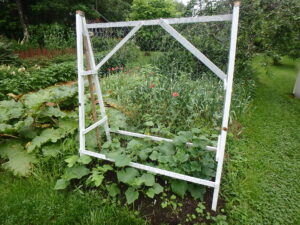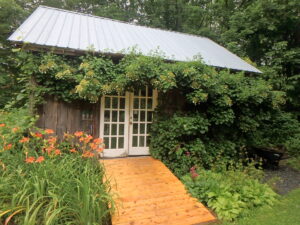Is It Time to Grow Up? Vines Offer Special Features
Posted on Tuesday, July 13, 2021 · Leave a Comment
The story of Jack, of Bean Stalk fame, appealed to me as a boy, and still does. I love climbing vines and grow many including those that are perennial or annual flowers, and some vegetables. Vines are a great way to save space and to get blossoms up and visible.

A cucumber trellis is easy to build
In the vegetable garden I have had great luck growing cucumbers on trellises. I made a simple frame to support my cukes, and you can, too. You can use 4 six-foot long 2-by-2 pieces of lumber for the framework. Attach them in pairs with simple gate hinges from the hardware store. Then space them five-feet apart with pieces of strapping at the top and bottom, and attach chicken wire for the vines to grab onto.
I used a cordless drill and short sheet rock screws to put it all together. I made it sturdier by cutting short pieces of strapping to go from the front legs to the back legs. To ensure it doesn’t blow over, I drove in a hardwood grade stake into the ground on each end, and screwed it to that strapping. Once the vines are long enough, lift them up onto the chicken wire, and they will quickly attach to it and grow up.
Other vines will grow up on trellises, too, including squashes and gourds of all sorts. For heavier fruits you may want to build your trellis with two-by-fours, and perhaps to use stronger wire mesh or the stuff used to reinforce concrete that comes in 4-foot by 8-foot pieces.
If you have only grown bush beans, you should also try pole beans. As the name implies, these will encircle a pole and grow up 8-feet or more. The great thing about them is that if you keep on picking them, they will produce beans all summer. Bush beans produce just one load of beans over a 3-week period, and then they are done.
Beans fix nitrogen, taking it from the air and storing it in useable form in nodes in the roots, but only if the soil has a certain bacteria to work with your beans. You can buy ‘inoculant’ to make sure your beans do fix nitrogen, and can add some to the soil and water it in, even now.

Climbing hydrangea covers the north side of my barn and looks good all year
Climbing hydrangea is a perennial woody vine that looks good all year. It is slow to get started, but once established (after a few years) it grows quickly. It does well on the shady north side of a building, a place often difficult for flowers. It will attach to brick or stone, but needs to be attached to a wood building, either with a trellis or individual ties. It blooms in June, but the large white panicles look good long after, even into winter.
There are many types of clematis but all have wonderful blossoms, some 6-inches wide or more, others small but profuse. Most will grow 6 to 10-feet tall; some die back to the ground each year, others have woody vines that send out new shoots and flowers each year. The key to success is to give the vines plenty of sunshine, but to protect the roots with shade from other plants to keep them cool. There are spring, summer and fall bloomers. Some are fragrant, others not.

This fall-blooming clematis had hundreds of blossoms
If you have lived in a warmer part of the country you may long for wisteria, a woody vine that blooms profusely with blue or purple flowers, and occasionally in shades of pink and white. Each blossom is actually a cluster of blossoms that hang down like a cluster of grapes. Although most wisteria varieties will survive our winters, most bloom on “old wood” and the flower buds get killed in winter.
I grow two varieties that do bloom in Zone 4 because they bloom on “new wood”, or this year’s growth. One is called ‘Blue Moon’, a hybrid developed in Minnesota. The other is ‘Amethyst Falls’, a native variety with smaller leaves and blossoms. Both bloom for me in late June or early July, and re-bloom lightly throughout the summer.
Annual vines are vigorous and delightful, too. We generally grow morning glories from seed. These come in many colors: reds, pinks, blue, purple and white. My favorite is called Grampa Ott. It is a deep purple, and can grow up to 15 feet in a season. It was one of two heritage plants that inspired the creation of the Seed Saver organization and seed company. They grow quickly so it’s not too late to plant some by seed.
Two decorative flowering beans that I like are purple hyacinth bean and scarlet runner bean. The purple hyacinth bean is a beautiful plant: the leaves are purple, along with the flowers and seed pods. It is slow to germinate and get up a pole or trellis, so it is best started in pots indoors before it can be planted outdoors. The young beans are edible raw or cooked, but the mature pods has seeds better used as dry beans.
Scarlet runner beans, like the hyacinth bean, can climb up a support and grow 10-feet in a season. They are quicker to grow than hyacinth beans, and I often start them in the soil near my hexagon cedar shade structure where I also grow wisteria. The bean has bright orange flowers and standard bean leaves. Plant 4 to 6 seeds around a pole and watch them grow- just like Jack, the bean stalk kid.





